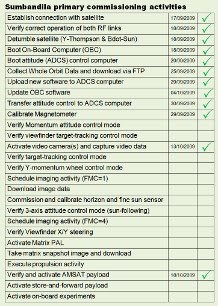Sumbandila completed 457 orbits during its first month in space which corresponds to 0.1316 AU (1 AU = distance between Earth and Sun). We managed to make successful contact with the satellite during all the available* passes over the Stellenbosch ground station, namely 107 (or roughly 23% of all orbits). During these 107 ground station passes, we had a total contact time with the satellite of roughly 15 hours.

SunSpace was established in 2000 as a spin-off from Stellenbosch University following the successful launch of SUNSAT by NASA with a Delta-II launch vehicle. During the past decade SunSpace has developed and delivered numerous satellite components, subsystems and two flight model satellite, now operational in space. This blog documents the mission of Sumbandila (funded by the DST), launched on a Soyuz-2.1b on 17 September 2009. SunSpace places a high premium on a strong partnership with the South African Government for supplying the ongoing satellite needs of our government.
17 October 2009
13 October 2009
First video received from the satellite
We are blessed - have received the first real-time video images from the satellite during the two morning passes! The signal was simultaneously received by the ground station at Stellenbosch University and the one at SAC (Hartebeeshoek) - the one in Stellenbosch with a 4.2m dish and the one at SAC with a 10m dish. The signal-to-noise ratio of the latter was obviously much better.
12 October 2009
Effects of radiation
We have noticed that some of the SRAM devices in use on the satellite are sensitive to Single Event Effects (due to radiation). This typically manifests as increased current.
All our electronics are protected by latch-up circuitry, but some of the increases in currents observed are below the set thresholds of the built-in trip functionality of these circuits.
We have now implemented a further protection mechanism in software which necessitated code uploads to the main on-board computer, some of the power distribution units, as well as the attitude computer.
In parallel we continue to perform minor commissioning activities and regular health checks. We plan to resume commissioning of the attitude control systems this week.
Subscribe to:
Posts (Atom)
Current Keplerian Elements
Last Update: 1 Febr 2010
Element set: 404
Sumbandila 1 35870U 09049F 10032.48635300 .00000433 00000-0 21444-4 0 4040 2 35870 097.3525 084.8560 0011505 166.1189 300.7196 15.22856092 20818

